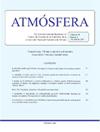Will Mexico meet its climate commitments?
IF 1
4区 地球科学
Q4 METEOROLOGY & ATMOSPHERIC SCIENCES
引用次数: 0
Abstract
In its Nationally Determined Contribution (NDC), Mexico is committed to reducing unconditionally 22 and 51% of its emissions of greenhouse gases (GHGs) and black carbon, respectively, by 2030, with an emission peak in 2026. Additional reductions of 36 and 70%, respectively, are proposed conditioned to support from other parties. In this work, the percentage of reduction to reach the emission mitigation targets that Mexico proposed in its NDC is estimated. The results show that in order to meet its unconditional NDC, Mexico should start mitigation in 2020 with a 1.5% reduction rate until 2030 and a 3.3% reduction rate by 2050, to reach an emission peak in 2023. To meet the conditional NDC, a 3.1% emission reduction rate until 2030 should be applied, with peak emission in 2021, and 5.8% from 2030 to 2050. In none of these estimates an emission peak in 2026 matches the NDC mitigation options. Furthermore, none of the emissions reduction pathways estimated in this study fulfills the conditional or unconditional contribution and peaks in 2026 at the same time. Mexico has a long history in international climate policy and is a key emerging economy among the top 15 highest GHG emitters. If Mexico does not achieve its NDC, the international implications, both political and climatic, could put the NDC model at risk if there are more large emitters that do not comply with their contribution.墨西哥会履行其气候承诺吗?
在其国家自主贡献(NDC)中,墨西哥承诺到2030年无条件地分别减少22%和51%的温室气体和黑碳排放,2026年达到排放峰值。提议的额外削减幅度分别为36%和70%,条件是得到其他各方的支持。在这项工作中,估计了墨西哥在其国家数据中心中提出的达到减排目标的减排百分比。结果显示,为了实现其无条件NDC,墨西哥应在2020年开始减排,到2030年减排1.5%,到2050年减排3.3%,以在2023年达到排放峰值。为了满足有条件的NDC,应在2030年前采用3.1%的减排率,2021年达到峰值,2030年至2050年达到5.8%。在这些估计中,2026年的排放峰值都与NDC的缓解方案不匹配。此外,本研究中估计的减排途径都没有达到有条件或无条件的贡献,并在2026年达到峰值。墨西哥在国际气候政策方面有着悠久的历史,是温室气体排放量排名前15位的主要新兴经济体。如果墨西哥不能实现其国家数据中心,如果有更多的大型排放国不遵守其贡献,那么政治和气候方面的国际影响可能会使国家数据中心模式面临风险。
本文章由计算机程序翻译,如有差异,请以英文原文为准。
求助全文
约1分钟内获得全文
求助全文
来源期刊

Atmosfera
地学-气象与大气科学
CiteScore
2.20
自引率
0.00%
发文量
46
审稿时长
6 months
期刊介绍:
ATMÓSFERA seeks contributions on theoretical, basic, empirical and applied research in all the areas of atmospheric sciences, with emphasis on meteorology, climatology, aeronomy, physics, chemistry, and aerobiology. Interdisciplinary contributions are also accepted; especially those related with oceanography, hydrology, climate variability and change, ecology, forestry, glaciology, agriculture, environmental pollution, and other topics related to economy and society as they are affected by atmospheric hazards.
 求助内容:
求助内容: 应助结果提醒方式:
应助结果提醒方式:


